Ball python
The ball python (Python regius), also called the royal python, is a python species native to West and Central Africa, where it lives in grasslands and shrublands. It is listed as Least Concern on the IUCN Red List because of its wide distribution. It is threatened by hunting for its meat and for the international pet trade.[1] This nonvenomous constrictor is the smallest of the African pythons, growing to a maximum length of 182 cm (72 in).[2] The name "ball python" refers to its tendency to curl into a ball when stressed or frightened.[3]
| Ball python | |
|---|---|
 | |
| Scientific classification | |
| Kingdom: | Animalia |
| Phylum: | Chordata |
| Class: | Reptilia |
| Order: | Squamata |
| Suborder: | Serpentes |
| Family: | Pythonidae |
| Genus: | Python |
| Species: | P. regius |
| Binomial name | |
| Python regius (Shaw, 1802) | |
 | |
| Distribution map of ball python | |
| Synonyms | |
Taxonomy
Boa regia was the scientific name proposed by George Shaw in 1802 for a pale variegated python from an indistinct place in Africa.[4] The generic name Python was proposed by François Marie Daudin in 1803 for non-venomous flecked snakes.[5] Between 1830 and 1849, several generic names were proposed for the same zoological specimen described by Shaw, including Enygrus by Johann Georg Wagler, Cenchris and Hertulia by John Edward Gray. Gray also described four specimens that were collected in Gambia and were preserved in spirits and fluid.[6]
Description
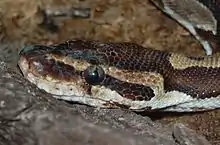
The ball python is black or dark brown with light brown blotches on the back and sides. Its white or cream belly is scattered with black markings. It is a stocky snake with a relatively small head and smooth scales.[3] It reaches a maximum adult length of 182 cm (6.0 ft). Males typically measure eight to ten subcaudal scales, and females typically measure two to four subcaudal scales.[7] Females reach an average snout-to-vent length of 116.2 cm (45.7 in), a 44.3 mm (1.74 in) long jaw, an 8.7 cm (3.4 in) long tail and a maximum weight of 1.635 kg (3.60 lb). Males are smaller with an average snout-to-vent length of 111.3 cm (43.8 in), a 43.6 mm (1.72 in) long jaw, an 8.6 cm (3.4 in) long tail and a maximum weight of 1.561 kg (3.44 lb).[8] Both sexes have pelvic spurs on both sides of the vent. During copulation, males use these spurs for gripping females.[9] Males tend to have larger spurs, and sex is best determined by manual eversion of the male hemipenes or inserting a probe into the cloaca to check the presence of an inverted hemipenis.[10]
Distribution and habitat
The ball python is native to west Sub Saharan Africa from Senegal, Mali, Guinea-Bissau, Guinea, Sierra Leone, Liberia, Ivory Coast, Ghana, Benin, and Nigeria through Cameroon, Chad, and the Central African Republic to Sudan and Uganda.[1] It prefers grasslands, savannas, and sparsely wooded areas.[3]
Behavior and ecology
This terrestrial species is known for its defense strategy that involves coiling into a tight ball when threatened, with its head and neck tucked away in the middle. In this state, it can literally be rolled around. Favored retreats include mammal burrows and other underground hiding places, where they also aestivate. In captivity, they are considered good pets, with their relatively small size and placid nature making them easy to handle.[3] Males tend to display more semi-arboreal behaviours, whilst females tend towards terrestrial behaviours.[11]
Diet
The diet of the ball python in the wild consists mostly of small mammals such as rodents, shrews and birds. Young ball pythons of less than 70 cm (28 in) prey foremost on small birds. Ball pythons longer than 100 cm (39 in) prey foremost on small mammals. Males prey more frequently on birds, and females more frequently on mammals.[11]
Reproduction
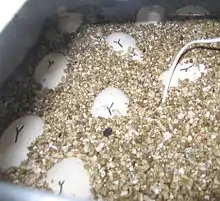
Females are oviparous and lay three to 11 rather large, leathery eggs.[7] They incubate them underground with a shivering motion. They hatch after 55 to 60 days. Young male pythons reach sexual maturity at 11–18 months, and females at 20–36 months. Age is only one factor in determining sexual maturity and the ability to breed; weight is the second factor. Males breed at 600 g (21 oz) or more, but in captivity are often not bred until they are 800 g (28 oz), although in captivity, some males have been known to begin breeding at 300–400 g (11–14 oz). Females breed in the wild at weights as low as 800 g (28 oz) though 1,200 g (42 oz) or more in weight is most common; in captivity, breeders generally wait until they are no less than 1,500 g (53 oz). Parental care of the eggs ends once they hatch, and the female leaves the offspring to fend for themselves.[10]
In captivity
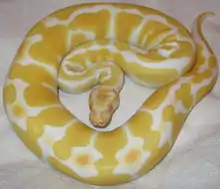
%252C_Bronx_Zoo.jpg.webp)
Python breeders have developed many morphs with altered colors and patterns.[12] Wild-caught specimens have greater difficulty adapting to a captive environment, which can result in refusal to feed, and they generally carry internal or external parasites. Specimens have survived for up to 60 years in captivity, with the oldest recorded ball python being kept in captivity 62 years, 59 of those at the Saint Louis Zoo.[13] Although the popularity of python breeding has led to more captive-bred ball python pets, it is often cheaper to import them from the wild, and tens of thousands are exported from West Africa each year.[14] The conservational impact on the native population is not well documented.[14]
Most captive ball pythons accept common rats and mice, and some eat birds, such as chicken and quail.[15] Some keepers feed their ball pythons multimammate mice, which ball pythons would naturally feed on in the wild.[11] Feeder animals are typically sold frozen and thawed by owners to feed to their pythons. Another option for feeding ball pythons is with live food, where the prey is purchased alive and is either killed by the owner and immediately offered to the snake, or set loose and allowed to be 'hunted' by the snake. Live feeding is rarely used in some areas, such as the United Kingdom, where, while not expressly prohibited, is considered a legal gray area due to animal welfare laws which prohibit the suffering of vertebrates.[16] It is generally not recommended to allow the snake to 'hunt' its food as the prey's defensive instinct can cause the prey to fight back, causing injury, and even death to the snake.[17] Younger ball pythons may eat as often as every 5 days, but as they mature, ball pythons tend to wait longer between meals, ranging between 7 and 14 days as adults. A ball python will typically not eat when it is shedding.[18]
Breeding
Ball pythons are one of the most common reptiles bred in captivity. They usually are able to produce a clutch of six eggs on average, but clutch sizes also range from one to eleven. Ball pythons reach sexual maturity at the age of two to two and a half years and a weight of 1500 grams.[19] These snakes usually lay one clutch per year and the eggs hatch around sixty days later. Usually, these eggs are artificially incubated in a captive environment at temperatures between 88–90 degrees Fahrenheit. Some captive breeders use ultra-sounding technology to verify the progress of reproductive development. This can help to increase the chances of successful fertilization as the ultra-sound can help predict the best times to introduce males and females during the breeding season.[20]
In captivity, ball pythons are often bred for specific patterns, or morphs.[21] While most of them are solely cosmetic, some have come under controversy due to inherited physical or cognitive defects associated with the inherited pattern. It has been shown that the spider morph gene is connected with major neurological issues, specifically related to the snake's sense of balance.[22] The International Herpetological Society banned the sale of such morphs at their events.[23] Captive ball pythons are available in hundreds of different color patterns.[24] Some of the most common are pastel, albino, mojave, lesser, and axanthic. Breeders are continuously creating new designer morphs, and over 6,500 different morphs currently exist.[25]
General husbandry
While ball pythons can make excellent pets for those unfamiliar with keeping snakes as a pet, ball pythons still require specialized care and attention.
Over the course of their life, a ball python requires a number of different sizes of enclosure in order to meet its needs as it grows; their enclosures can consist of designated reptile terrariums, plastic tubs, or aquarium tanks. Ball pythons can be adept at escaping from their enclosures, meaning that their habitat should be kept secure so as to prevent escape.
The snake's enclosure should be kept well-ventilated, and it is recommended that the snake be able to stretch out fully within its enclosure without having to bend or curl up to fit; many keepers recommend a 30–50-gallon tank for an adult ball python.[26]
It is also recommended that ball pythons have some form of enrichment in their enclosure, generally defined as something that allows the snake to exhibit behaviors they would naturally display in the wild, such as exploration. This can be something as simple such as fake leaves and/or a cardboard roll, or a more extensive form of enrichment, such as live plants and sculpted backgrounds that allow the snake to climb. Enrichment is considered important, as captivity generally does not provide the same level of activity or positive stimulation as a ball python's natural habitat, and so must be added in by the keeper. Enrichment is generally thought to improve a captive snake's general health and wellbeing.[27]
In the wild, ball pythons are naturally found in tropical areas with relatively high temperatures, and as such, should be kept in a thermoregulated enclosure. Because snakes rely on their environment for thermoregulation, there should be a range of temperatures throughout the enclosure; this is best achieved with a heat mat placed underneath the enclosure, monitored with a thermostat. It is recommended that one side of the snake's enclosure stay at roughly 92 °F (33 °C), with the other measuring at roughly 78 °F (26 °C), mimicking shade and direct sunlight and allowing the snake to thermoregulate between the two.[28]
Like most snakes, ball pythons benefit from a 'hide' or a small cave, allowing them to the ability to retreat from the 'open ground' of their enclosure; this may simply be an upturned plastic bowl with a small entryway cut into it. It is recommended that ball pythons have a 'hide' on both the hot and cool sides of the temperature gradient so that they don't have to choose between a comfortable temperature and a safe, dark place, as they are nocturnal and prefer to sleep in the day.[29]
The humidity of a ball python's enclosure should be kept around 50-60%. This mimics the natural environment of the ball python. During shed, the humidity should be closer to 70-80% to assist the snake in shedding, allowing them to remove their skin entirely on their own.
A ball python's enclosure is usually filled with a small layer of substrate – an earth-like substance allowing the snake to move easily through friction with the substrate itself, and also assisting in shedding by giving the snake something to rub against to help loosen dead skin. Substrate can consist of coconut husk and mulch, though paper towels and newspapers are also used; substrate choices must be considered as the type of substrate chosen for a ball python's environment will have an effect on the humidity of the enclosure.
Bioactive enclosures imitate a natural environment and are becoming increasingly popular with ball python keepers. Bioactive enclosures rely on the inclusion of elements such as live plants, leaf litter, moss, and 'custodians' in the form of springtails and isopods such as tropical woodlice to mimic an ecosystem in the enclosure.[30] The 'custodians' live in the substrate – typically a mixture of coconut husk and natural soil – and help to break down waste produced by the snake, including shed skin, which can help with cleanliness and upkeep.[31]
In culture
The ball python is particularly revered by the Igbo people in southeastern Nigeria, who consider it symbolic of the earth, being an animal that travels so close to the ground. Even Christian Igbos treat ball pythons with great care whenever they come across one in a village or on someone's property; they either let them roam or pick them up gently and return them to a forest or field away from houses. If one is accidentally killed, many communities on Igbo land still build a coffin for the snake's remains and give it a short funeral.[32] In northwestern Ghana, there is a taboo towards pythons as people consider them a savior and cannot hurt or eat them. According to folklore a python once helped them flee from their enemies by transforming into a log to allow them to cross a river.[33]
Gallery
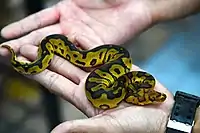 Clown ball python
Clown ball python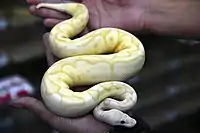 what seems to be a Banana butter Clown ball python
what seems to be a Banana butter Clown ball python Tiger shade ball python
Tiger shade ball python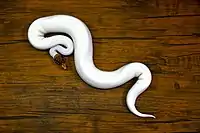 "Spied" ball python, a combination of the spider and piebald morphs
"Spied" ball python, a combination of the spider and piebald morphs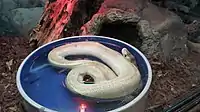 Butter champagne ball python, a combination of the butter and champagne morphs
Butter champagne ball python, a combination of the butter and champagne morphs
References
- Auliya, M.; Schmitz, A. (2010). "Python regius". IUCN Red List of Threatened Species. 2010: e.T177562A7457411. doi:10.2305/IUCN.UK.2010-4.RLTS.T177562A7457411.en. Retrieved 13 March 2018.
- McDiarmid, R. W.; Campbell, J. A.; Touré, T. (1999). Snake Species of the World: A Taxonomic and Geographic Reference. 1. Washington, DC: Herpetologists' League. ISBN 1-893777-00-6.
- Mehrtens, J. M. (1987). "Ball Python, Royal Python (Python regius)". Living Snakes of the World in Color. New York: Sterling Publishers. p. 62–. ISBN 080696460X.
- Shaw, G. (1802). "Royal Boa". General zoology, or Systematic natural history. Volume III, Part II. London: G. Kearsley. pp. 347–348.
- Daudin, F. M. (1803). "Python". Histoire naturelle, générale et particulière, des reptiles. Tome 8. Paris: De l'Imprimerie de F. Dufart. p. 384.
- Gray, J. E. (1849). "The Royal Rock Snake". Catalogue of the specimens of snakes in the collection of the British museum. London: The Trustees. pp. 90–91.
- Barker, D. G.; Barker, T. M. (2006). Ball Pythons: The History, Natural History, Care and Breeding. Pythons of the World. 2. Boerne, TX: VPI Library. ISBN 0-9785411-0-3.
- Aubret, F.; Bonnet, X.; Harris, M.; Maumelat, S. (2005). "Sex Differences in Body Size and Ectoparasite Load in the Ball Python, Python regius". Journal of Herpetology. 39 (2): 315–320. doi:10.1670/111-02N. JSTOR 4092910. S2CID 86230972.
- Rizzo, J. M. (2014). "Captive care and husbandry of ball pythons (Python regius)". Journal of Herpetological Medicine and Surgery. 24 (1): 48–52. doi:10.5818/1529-9651-24.1.48. S2CID 162806864.
- McCurley, K. (2005). The Complete Ball Python: A Comprehensive Guide to Care, Breeding and Genetic Mutations. ECO & Serpent's Tale Natural History Books. ISBN 978-097-131-9.
- Luiselli, L. & Angelici, F. M. (1998). "Sexual size dimorphism and natural history traits are correlated with intersexual dietary divergence in royal pythons (Python regius) from the rainforests of southeastern Nigeria". Italian Journal of Zoology. 65 (2): 183–185. doi:10.1080/11250009809386744.
- (P. regius) Base Mutations at Graziani Reptiles. Accessed 12 September 2007.
- "A new squeeze? Snake mystery after lone, elderly python lays a clutch of eggs". 2020. Retrieved 11 September 2020.
- "Python exports from West Africa raise alarms as demand for popular pet grows". Animals. 31 March 2020. Retrieved 11 August 2020.
- McCurley, K. "Ball Python Care Sheet". ReptilesMagazine. Retrieved 27 February 2019.
- "House of Commons – Environment, Food and Rural Affairs – Minutes of Evidence". publications.parliament.uk. Retrieved 11 August 2020.
- Moore, Matthew (9 October 2008). "Mouse bites snake to death". The Daily Telegraph. ISSN 0307-1235. Retrieved 11 August 2020.
- "Feeding Royal (Ball) pythons". Exoticdirect. Retrieved 11 August 2020.
- "Ball Python Care Sheet". Reptile Range. Retrieved 28 January 2021.
- Bertocchi, P. (2018). "Monitoring the reproductive activity in captive-bred female ball pythons (P. regius) by ultrasound evaluation and noninvasive analysis of faecal reproductive hormone (progesterone and 17β-estradiol) metabolites trends". PLOS ONE. 13 (6): e0199377. Bibcode:2018PLoSO..1399377B. doi:10.1371/journal.pone.0199377. PMC 6021098. PMID 29949610.
- Bulinski, S. C. (2016). "A Crash Course in Ball Python/Reptile Genetics". Reptiles magazine.
- Rose, M. P. & Williams, D. L. (2014). "Neurologic dysfunction in a ball python (Python regius) color morph, and implications for welfare". Journal of Exotic Pet Medicine. 23 (3): 234–239. doi:10.1053/j.jepm.2014.06.002.CS1 maint: multiple names: authors list (link)
- "Breeders Meetings – New Policy – June 2017". International Herpetological Society. 2017.
- Yurdakul E. (2020). "Ball Python Morphs". Reptilian world.
- "Morph List – World of Ball Pythons". World of Ball Pythons. Retrieved 21 September 2017.
- "Awesome Information About the Habitat of a Ball Python". Pet Ponder. 8 February 2010. Retrieved 23 April 2020.
- Martin, Steve (October 1999). "Enrichment: What is it and Why Should You Want it?" (PDF). Natural Encounters, Inc: 4 – via World Zoo Conference.
- "Ball Python Cage Temperatures and Heating Tips – Reptile Knowledge". Retrieved 23 April 2020.
- "Ball Pythons". www.anapsid.org. Retrieved 11 August 2020.
- Child, J. (2019). Animal Welfare 101: How to Raise Unique Pets Such as Amphibians, Cats, Dogs, Fish, Reptiles, and More From A to Z. HowExpert. ISBN 978-1-64758-695-9.
- Divers, S. J.; Stahl, S. J. (2018). Mader's Reptile and Amphibian Medicine and Surgery- E-Book. Elsevier Health Sciences. ISBN 978-0-323-48248-6.
- Hambly, W. D.; Laufer, B. (1931). "Serpent worship". Fieldiana Anthropology. 21 (1).
- Diawuo, F.; Issifu, A. K. (2015). "Exploring the African Traditional Belief Systems in Natural Resource Conservation and Management in Ghana". Journal of Pan African Studies. 8 (9): 115–131.
External links
| Wikimedia Commons has media related to Python regius. |
| Wikispecies has information related to Python regius. |
- "Python regius". Integrated Taxonomic Information System. Retrieved 12 September 2007.
- Python regius at the Reptarium.cz Reptile Database. Accessed 12 September 2007.
- "Ball Python Articles and Care Sheets". rcreptiles.
- "Ball Python Care and Husbandry". Ball Python Care Net.
- "Ball Python Care Sheet".
- "Troubleshooting Guide for Ball Pythons".
- "Ball Pythons as Pets". Exotic Pets.
- "Ball Python, Python regius Care". reptileexpert.
- "Royal Python, Python regius Care". theroyalpython.
- "Exposure to Salmonella". CDC.
- "Ball Python care sheet". allanspetcenter.
- "Morphmarket Reptile Community". Morphmarket.
